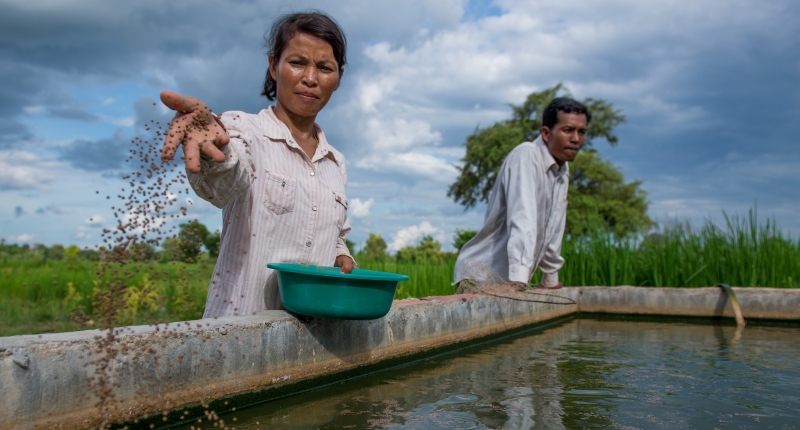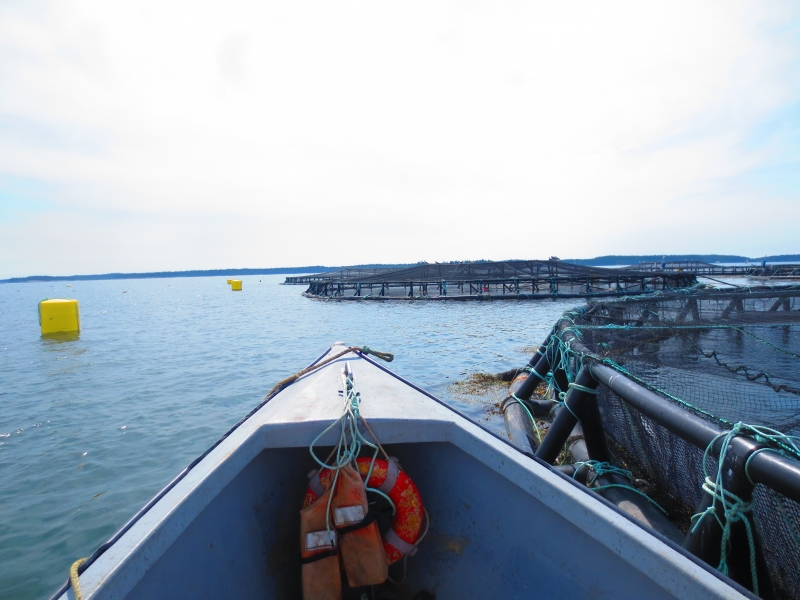Farming Fish Saves Land

If our future global population ate more seafood from aquatic farming, or aquaculture, to satisfy the anticipated growth in their protein needs, we may be able to substantially reduce one of the biggest environmental impacts of meat production – land use – without giving up meat entirely.
A new study from the National Center for Ecological Analysis and Synthesis (NCEAS) found the amount of cropland required to support future protein needs with more farmed aquatic animals would be significantly smaller than if terrestrial livestock met those needs. Published today in the Proceedings of the National Academy of Sciences, this research is the first land-use analysis of future food systems that focuses on aquaculture, the world’s fastest growing food sector, and helps reveal its potential role in conservation and food security.
“While aquaculture can add some pressure, because ultimately it is a food production system, our study demonstrates the relative amount is miniscule compared to terrestrially farmed animals,” says lead author Halley Froehlich, a postdoctoral researcher at NCEAS, which is part of UC Santa Barbara. “Aquaculture is not going to be the main strain on future crop feed and land use. It is and will likely continue to be terrestrial livestock.”
The United Nation’s Food and Agriculture Organization (FAO) and researchers around the world estimate current animal production will need to grow by an average of 52 percent by 2050 to meet the protein demands of the anticipated nearly 10 billion people. Meeting this demand without pushing the environment to the brink will be critical.
Given the rise of aquaculture, which currently accounts for half of global seafood production, along with the plateauing of wild-caught fisheries and the huge land footprint of terrestrial livestock, the researchers sought to understand what would happen if aquaculture satisfied the growth in protein needs and whether that would help or hinder efforts to soften the global food system’s impacts on land and biodiversity.
Aquaculture production depends on a number of land-based crops for feed, positioning it uniquely at the interface of aquatic and terrestrial food systems. To understand its land-use implications, the researchers examined how much land would be required to grow the seven most common crops used to feed both terrestrial livestock and farmed fish under three scenarios for the year 2050, synthesizing food production data from the FAO and other scientific sources.
The researchers compared a “business-as-usual” scenario, in which terrestrial meat consumption continues to dominate seafood consumption, to two scenarios in which aquaculture provides the additional protein demands of 2050’s global population – but still including meat as a food source. They found that replacing the added terrestrial production with aquaculture instead could spare a range of 729 to 747 million land hectares globally; that’s an area twice the size of India, the world’s seventh biggest country.

These savings, which also consider the substitution of land required for livestock grazing, would occur whether future aquaculture growth is completely marine-based or some mix of marine and freshwater, the two aquaculture scenarios they assessed to understand a range of possible futures.
Land savings would occur because fish and other aquatic animals are extremely efficient at converting feed to biomass for human consumption. For example, while a cow requires anywhere from six to over 30 pounds of feed to gain one pound of biomass, most farmed fish need just one to two pounds of feed to do the same. This efficiency translates into much less cropland required to grow feed for the fish people eat.
These results highlight the role food choices play in the future of biodiversity, the biggest threat to which is habitat lost to human land use.
“The expansion of agriculture across the world is driving most species extinctions and the dramatic loss of ecosystems. This is only going to increase into the future,” said co-author Clair Runge, who is a research scientist at University of Tromsø - the Arctic University of Norway and was a postdoctoral researcher at NCEAS at the time of the research. “Aquaculture offers one way to reduce some of this pressure on our natural landscapes, wild places and wildlife.”
Froehlich clarified their study does not position aquaculture as a panacea for sustainable food production. As with any food system, there will be tradeoffs. Nonetheless, their results build on mounting evidence for the potential of sustainable aquaculture production, such as recent research by four of this study’s authors that found marine aquaculture requires very little ocean space to produce an immense amount of food.
“Aquaculture does not have to be this massive burden on land or in the water, especially if farms are sited strategically and there are incentives for management that move it toward sustainable siting and feed practices. The potential is ripe to really do it right,” said Froehlich, adding that today’s policy decisions will matter in the future of food systems.
Co-author Ben Halpern, director of NCEAS and professor at UCSB’s Bren School of Environmental Science and Management, explains the results provide a clear reason for people to try shifting their diets away from meat and towards fish to reduce the environmental impacts of their food choices.
“What you eat has impact, but we understand shifting diets can be difficult. We hope that awareness of how much land can be spared under a fishier diet helps individuals make the change. Similarly, we hope our results put more 'fish on the bones' of policy arguments to make more systematic changes,” said Halpern.
Support for this study came from the Science for Nature and People Partnership, a collaboration between NCEAS, The Nature Conservancy and Wildlife Conservation Society.
